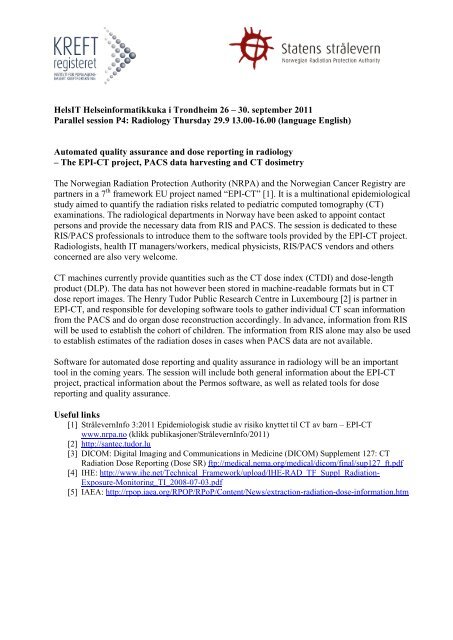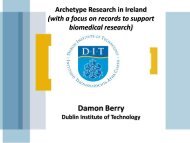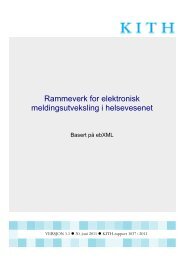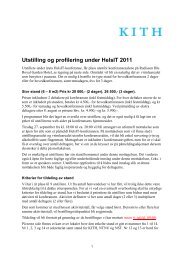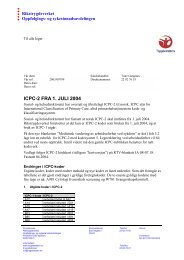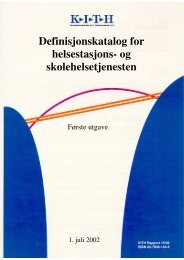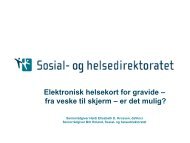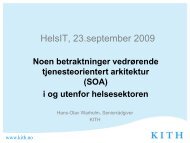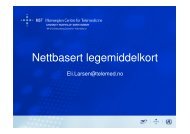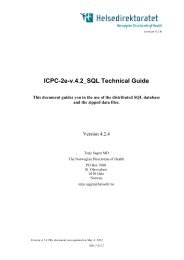HelsIT Helseinformatikkuka i Trondheim 26 – 30. september 2011 ...
HelsIT Helseinformatikkuka i Trondheim 26 – 30. september 2011 ...
HelsIT Helseinformatikkuka i Trondheim 26 – 30. september 2011 ...
You also want an ePaper? Increase the reach of your titles
YUMPU automatically turns print PDFs into web optimized ePapers that Google loves.
<strong>HelsIT</strong> <strong>Helseinformatikkuka</strong> i <strong>Trondheim</strong> <strong>26</strong> <strong>–</strong> <strong>30.</strong> <strong>september</strong> <strong>2011</strong>Parallel session P4: Radiology Thursday 29.9 13.00-16.00 (language English)Automated quality assurance and dose reporting in radiology<strong>–</strong> The EPI-CT project, PACS data harvesting and CT dosimetryThe Norwegian Radiation Protection Authority (NRPA) and the Norwegian Cancer Registry arepartners in a 7 th framework EU project named “EPI-CT” [1]. It is a multinational epidemiologicalstudy aimed to quantify the radiation risks related to pediatric computed tomography (CT)examinations. The radiological departments in Norway have been asked to appoint contactpersons and provide the necessary data from RIS and PACS. The session is dedicated to theseRIS/PACS professionals to introduce them to the software tools provided by the EPI-CT project.Radiologists, health IT managers/workers, medical physicists, RIS/PACS vendors and othersconcerned are also very welcome.CT machines currently provide quantities such as the CT dose index (CTDI) and dose-lengthproduct (DLP). The data has not however been stored in machine-readable formats but in CTdose report images. The Henry Tudor Public Research Centre in Luxembourg [2] is partner inEPI-CT, and responsible for developing software tools to gather individual CT scan informationfrom the PACS and do organ dose reconstruction accordingly. In advance, information from RISwill be used to establish the cohort of children. The information from RIS alone may also be usedto establish estimates of the radiation doses in cases when PACS data are not available.Software for automated dose reporting and quality assurance in radiology will be an importanttool in the coming years. The session will include both general information about the EPI-CTproject, practical information about the Permos software, as well as related tools for dosereporting and quality assurance.Useful links[1] StrålevernInfo 3:<strong>2011</strong> Epidemiologisk studie av risiko knyttet til CT av barn <strong>–</strong> EPI-CTwww.nrpa.no (klikk publikasjoner/StrålevernInfo/<strong>2011</strong>)[2] http://santec.tudor.lu[3] DICOM: Digital Imaging and Communications in Medicine (DICOM) Supplement 127: CTRadiation Dose Reporting (Dose SR) ftp://medical.nema.org/medical/dicom/final/sup127_ft.pdf[4] IHE: http://www.ihe.net/Technical_Framework/upload/IHE-RAD_TF_Suppl_Radiation-Exposure-Monitoring_TI_2008-07-03.pdf[5] IAEA: http://rpop.iaea.org/RPOP/RPoP/Content/News/extraction-radiation-dose-information.htm
PROGRAMMEP4 Thursday afternoon <strong>–</strong> Parallel session 13.00-16.00 (language English)Automated quality assurance and dose reporting in radiology<strong>–</strong> The EPI-CT project, PACS data harvesting and CT dosimetryChair: Hilde OlerudTime Heading Lecturer13:00 The EPI-CT projectKristina Kjærheim,<strong>–</strong> Introduction to the projectCancer Registry of<strong>–</strong> How to establish the cohort from RISNorway<strong>–</strong> Pseudonymisation, data security, ethics committeeapprovalDose reconstruction based on RIS and PACS data<strong>–</strong> Retrospectively based on 1995 national CT survey<strong>–</strong> Practical dose parameters in CT (CTDI and DLP)and how they currently are recorded in the PACSHilde M. Olerud,NRPA14:00 Coffee breakPerMoS: Automated data collection from PACS basedon DICOM<strong>–</strong> Introduction to the PerMos software<strong>–</strong> Data security<strong>–</strong> Initial experiencesSoftware tools for automated dose reporting andquality assurance in radiology based on DICOM<strong>–</strong> Optimage quality assurance software<strong>–</strong> Tudor DICOM software framework15:30 DiscussionLogistics, staff involvement, time scheduleAndreas Jahnen,Tudor ResearchCentre, LuxembourgAndreas JahnenAll16:00 END(Preliminary)Vi ber om at de som planlegger å delta på sesjonen P4:Radiologi gir oss beskjed om dette til:silje.flatabo@nrpa.no.Reisestøtte: For Helseforetakets utpekte RIS/PACS-kontaktperson til EPI-CT-prosjektet kanStatens strålevern etter søknad bidra med reisestøtte på kr. 2500,-. Reisestøtte er aktuelt for demsom skal bidra til datahøsting i de radiologiske avdelingene.
Abstract:PerMoS: Automated data collection and CT dosimetry from PACS forepidemiological researchAndreas Jahnen 1 , Johannes Hermen 1 , Prof. Dr. Peter Mildenberger 2 ,PD Dr. Gerald Weisser 3 , Lucian Krille 2Public Research Centre Henri Tudor, LuxembourgUniversity Medical Centre Mainz , GermanyUniversity Medical Centre Mannheim, GermanyThe EPI-CT project aims to collect an international cohort of paediatric patients undergoing CTexaminations to estimate cancer risk after exposure to low doses of ionizing radiation. This isdone by linkage with national cancer registries and analysis of cancer incidence in respect ofindividual radiation doses. The dosimetry information is calculated based on the technicalparameters of the images acquired during scan.The PerMoS <strong>–</strong> Performance and Monitoring Server for Medical Data is used to perform the datacollection from PACS. The lightweight, easy to install PerMoS Upload Client is used to query,treat and securely collect the pseudonymous technical DICOM header metadata and transfer it tothe central PerMoS Server. Each study participant can securely access the collected data with thePerMoS Data Manager - depending on their role within the study. Special CalculatorComponents at the server provide different evaluations, like different CT dosimetry calculations.Based on the aim and design of the European EPI-CT study, the software’s specific functionalityand design will be demonstrated. First implementations in Germany revealed preliminary resultson performance and acceptance during data collection as well as challenges in dosimetry andspecial characteristic of the retrieved data will be shows based on the experiences from theUniversity hospitals Mainz and Mannheim.The presentation will outline the aims and the design of the EPI-CT study as well as the softwaredesign and the software functions. The conclusions include first results, discuss the challenge ofdosimetry, the experiences during data collection and characteristics of the collected data.


